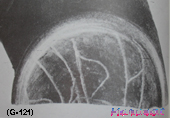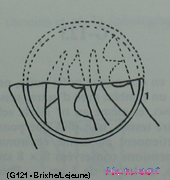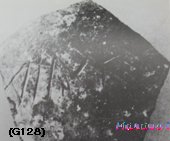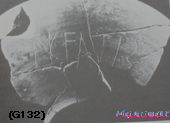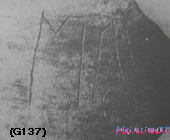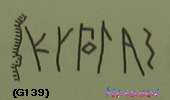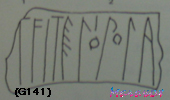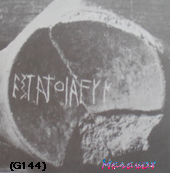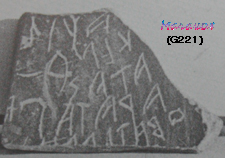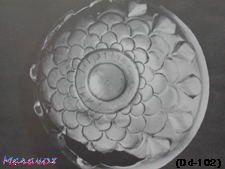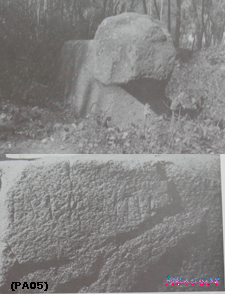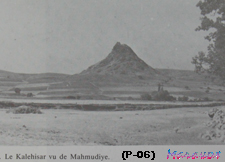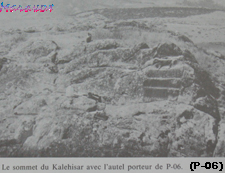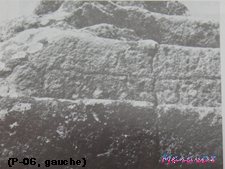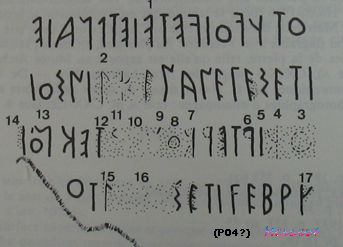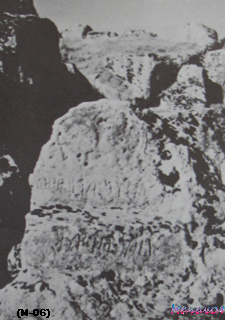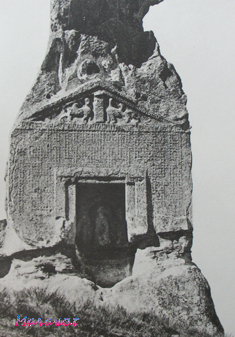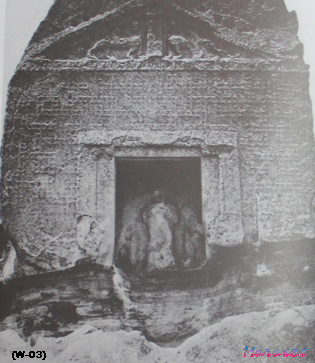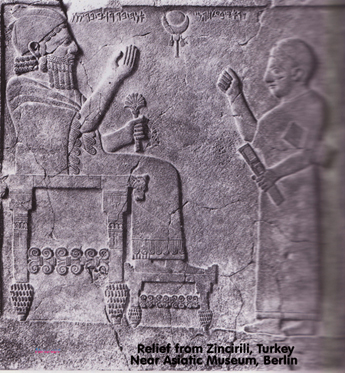|
11/5/2007 Phrygian language, translation showing conjugation and declension patterns and vocabulary.

The Phrygian language
Translation of Phrygian scripts (continued : Phrygian1.html)
by Mel Copeland
(Based on a related work, Etruscan Phrases,
first published in 1981)
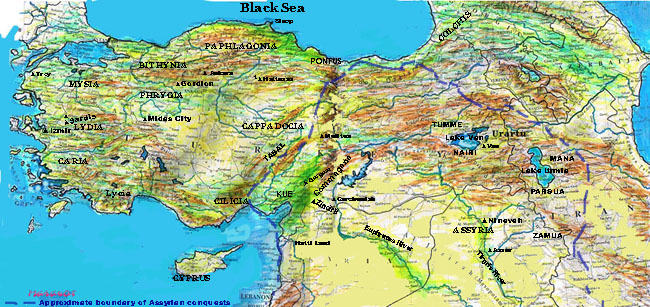
Phrygien inscriptions from "Corpus des Inscriptions Paléo-Phrygienne, Editions Recherche sur les Civilizations," by Claude Brixhe and Michel Lejeune, Institute Français D'etudes Anatoliennes, Paris 1984, Memoire # 45. (1)
|
|
|
Gordion – shards,
Gordion Museum
|
|
|
|
|
Script XJ-1 – BABA
|
|
|
|
Script XJ-2 TAPES
|
|
|
|
|
|
Script XJ-3 ATAS KE KI [Translation: you give (L. addo-addere) to us (It. ce) who, which, what, that (L. qui, quae, quod; It. chi; Fr. qui)
|
|
|
|
|
|
Script XJ-5 LVMAS TAEIA [Translation: priest's apron? (L. limus-i, m.) of Taeia, person (See also XA-8, TAEI)
|
|
|
|
|
|
Script XJ-7 TIVA (TYFA) TIS [Translation: god-like, divine (L. divus-a-um) Dis, god of Hades, Pluto (L. Dis, Ditis, dis, diti [from dives], rich; Gr. Ploutos) (See also XB-13, TIS)
|
|
|
|
|
|
Script XJ-9 API TEIA [Translation: water, to, to drink (L. beo-bere; It. bere; PIE*ap, hap, water) of the goddess (L. deus, divus, di, divi, dea, diva; It. dio, dia; Fr. dieu, dieux, deese) Note: See MS-24 which uses API in the context of drinking, winemaking.
|
|
|
|
|
|
Script XJ-11 MILAS, name
|
|
|
|
|
|
Script XJ-12 KIR, KUR (KYR) OPAS, rock, fortress (Semitic, kir) of wealth (L. ops, ope, opis, opes), possibly a name
|
|
|
|
|
|
Script XJ-14 ...P FITE NOROPA [Translation: ...p.. of life (L. vita-ae) of Noropa, name
|
|
|
|
|
|
Script XJ-16 FOINESOIS IRIIENO IS KI [Translation: the interest on money, debt, indebtedness (L. foen / faenus (fenus(-oris) of Iriieno (Ireneus) he, she, it, that person, thing (L. is, ea, id) who, which, what, that (L. qui, quae, quod; It. chi; Fr. qui)]
|
|
|
|
|
Script XJ-20 ES TA TOIA FIN (FYN) [Translation: you are (L. sum, esse, fui, futurus; 2nd pers. es) you, yours (L. tuus, vester; Fr. ta, thy, votre, your) the two (L. duo-ae) I bind, limit, enclose, apppoint, finish by speaking, or to die (L. finio-ire)]
|
|
|
|
Script XV-1 (Inscription on a rock, W-10, one of the faces of Gencel Yatagi, oriented towards the SSE) _ TAIE ELAE PER AFO [Translation: Taie, name? Possibly Ataie, Hades? of Elea or Vella-ae, fown in Lucania? for, through, by (L. per; It. per; Fr. par) to carry, bear away (L. aveho-vehere)]
XV-6 FICHE (FI E) or FITE ATE FOATO IOS [Translation: fig, fig tree? (L. ficus-i and -us) or alternatively, life, existence (L. vita-ae) of Attis? fetus, pregnant, fruitful (L. fetus-a-um) of the right, law, a court of justice, jurisdiction (L. ius, iuris)] E) or FITE ATE FOATO IOS [Translation: fig, fig tree? (L. ficus-i and -us) or alternatively, life, existence (L. vita-ae) of Attis? fetus, pregnant, fruitful (L. fetus-a-um) of the right, law, a court of justice, jurisdiction (L. ius, iuris)]
XV-11 APIS SICH E TOLAS [Translation: you go away, depart (L. abeo-ire; 2nd pers. abis; apis, apes-is, bee; Apis-is, Egyptian ox-god) thus, so, in this way, like this (L. sic) from, out of from, out of, after (L. e, ex) artifice, fraud, deciet, guile, a trap (L. dolus-i)
|
|
|
Shards and altars
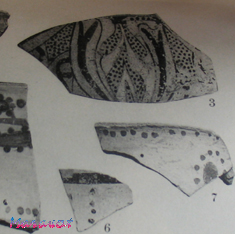 |
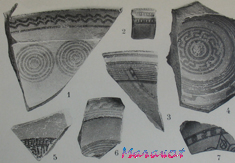 |
 |
 |
|
Script XK-1 RONO POS: ENE PARKES PETES [Translation: to Rono I avail, have influence, pose (L. possum, posse, potui): you escape by swimming (L. eno-are) Parca, goddess of fate, the Three Fates (L. parca-ae) you petition, to make for, go for (L. peto-ere; 2nd pers. petis, subj. petas)]
|
|
|
|
|
|
Script XL-1 TALOS: IMAN BATIN [Translation: the heel, talon (L. talus-i) horrible (L. immanis-e) they beat, knock (L. battuo [batuo]-are)]
|
|
|
|
|
|
|
Script XM-1 ARIS KUNA (KFNA) ATAS ARA TAPA OBATIM _ [Translation: to Ares he conspires, takes an oath (L. coniuro-are; It. congiurare) Atas, name, the altar (L. ara-ae) of Tapa, name, set, dead; of heavely bodies, to set; of living, to die (L. obeo-ire-ivi-itum)]
|
|
|
|
|
|
Script XM-1 MANK TAS SOK POSA [Translation: maimed, crippled, imperfect, defective (mancus-a-um) I am silent, quiet (L. taceo-ere; It. tacere; Fr. tacite, tacit) I unite, combine, associate (L. socio-are)? he avails, poses (L. possum, posse, potui)
XM-5 MAMU or MAMI (MAMY), TASI TOIE SIPO KA [Translation: Mamu, name, I was silent, the two (L. duo-ae) I enclose, hedge in (L. saepio, saepire; It. sipario, a curtain) by which way, where, whereby, as far as (L. qua), or alternatively, Sipoka, name]
|
|
|
|
|
|
Script XR-1 SYD or SYR PASTOS INAS or SANI [Translation: to the sister (L. soror-oris; It. suora; Fr. soeur; Tocharian, sar; Irish sier; Pers., xahar) food, pasture (L. pastus-us) healthy (L. sanus-a-um); to heal, cure (L. sano-are; It. sanare; )]
|
|
|
|
|
|
Script XN-1 ATES ITO_ [Translation: Attis ....(last character of ito_ unreadable)
|
|
|
|
|
Script XP-1 FAS IS KANU, KANI TIE [Translation: to fate (L. fas) he, she, it, that person, thing (L. is, ea, id) thing you sang, chanted, prophesied (L. cano, canere) of the day (L. dies-ei, day; diu, by day; diutiuus, longer; Welsh, dydd; Scot, di)]
|
|
|
|
|
|
|
|
|
|
|
|
Script XQ-1 AK ITIF LUS, LIS (LYS) [Translation: and, and also, and indeed (L. ac, atque) I went, moved of the light (L. lux, lucis; Tocharian, luks; Lycian, luga; Hittite, lukkai)]
XQ-4 AIS IOS LES KETIO IFI : PSEIN [Translation: to the bronze, metal (L. aes, aeris) of the right, law, a court of justice, jurisdiction (L. ius, iuris) the law (L. les, legis) of Ketio, name? of eternity, lifetime (L. aevum-i; aeus-i) they play on or sing to a stringed instrument (L. psallo-psalleere)]
|
|
|
|
|
|
XU-1 NATIM ESON NAI [Translation: born, to be (L. nascor-i; pluperf. 3rd pers. Pl, natierant; natus-a-um, part.) I make a sound, celebrate (L. sono, sonere, sonui) the birth born, to be L. nascor-i)]
|
|
|
|
Altars and monuments
 |
|
|
Script XO-1 OTU, OTI (OTY) FOI FET VIE (FIE) TINAIE [Translation:
XO-6 IOS NIP_E NANE PES ETI [Translation:
XO-11 ORIR TERU, TERI (TERY) R_ _ _TEK MOI [Translation:
XO-15 OTP _ _ _SETI FEBRO [Translation:
|
|
|
|
|
|
|
|
Script XW-1 SFS E _ SIA L (cannot read)
|
|
|
|
|
|
|
Script XS-1 REKUN, REKIN LEIA TIPE E AF
[Translation: they rule, support (L. regno-are; rego, regere; It. reggere; Fr. regler; Sanscrit, raj) or alternatively, or alternatively, they request, require (L. requiro-quirere; It. requisire; Fr. requirer) of the lioness (L. lea-ae and laena) model, figure on a wall, type (L. typus-i; It. tipo; Fr. type; Gr. typos, Polish, typ) out of, from (L. e, ex) the goddes AF (Aph)]
XS-5 ALTO LIMAN [Translation: grown, great (L. altus-a-um) of the threshold, doorway, entrance, house, dwelling (L. limen-inis)]
Note: LEI is used in Etruscan scripts Q297, K74 and TC144. Of interest is the Sumerian goddess Innana (Akkadian, Ishtar) and her son-consort Dumuzzi. She was pictured as a goddess that stood atop a lion or was flanked by lions and associated with the Tree of Life. See www.crystalinks.com/sumergods1.html for more information of Innana. She may have been the prototype of the Phrygian Mater and her son-consort Attis. The direction this altar faces is relevant to the identification of the god/goddess inscribed here. It should be facing either the Spring, Summer or Winter solstice. If it is oriented to the Summer solstice, in Akkadian religion it was a time of mourning, according to crystalinks.com.
|
|
|
|
|
|
Script XT-1 IK ETA IOS: PSEILE SI IS [Translation: here (L. hic [and heic], hice; It. qui; Fr. ici) she brings out, produces, gives birth (L. edo-edere-didi-ditum) the law, right, court (L. ius, iuris): you play on or sing to a stringed instrument (L. psallo-psalleere) himself, herself, itself (L. se, sese; It. si; Fr. se) he, she, it, that person, thing (L. is, ea, id)]
The following is what Brixhe and Lejeune say about the monument which faces East.
"Près de Kümbet (environ 50 km N d'Afyon, 10 km W de la "Ville de Midas"), à 500 m à l'Est de la colline appelée Asar Kale, sur le flanc oriental d'un petit massif rocheu, petite façade avec inscription dextroverse monostique, gravée en arc de cercle au-dessus du tympan."
|
|
|
|
|
|
This monument has no visible inscription. It is identified by Brixhe and Lejeune as W-03. Compare the pediment to Script XT (W-02). Also, compare the top of this monument to the Areyastis Monument of Midas City, Script XB.
|
|
|
|
Script XW-1 SNEOGR (SNEoGR RIG : GUoM (GFoM). [Translation: Sennacherib, ruler or I rule (rex, lead, to (L. rigo-are; It. rigare) of Guom?] Note: The name resembles that of Seneferre Piye (753-713 B.C., 25th Dynasty). However, this appears to link to the name of Sennacherib (means "not the first born," 702-680 or 704-703 and 688-681 [second term] B.C.) of Assyria, son of Sargon II. Sennacherib was regarded as the most powerful of the Assyrians and conquered the Mediterranean lands, including Judah during the time of Hezekiah, and Egypt. "Guom" may refer to the people of Que.
XW-4 NUS At GOVERM (GOFERM) [Translation: our (L. nos; It. noi, nostro; Fr. nous, nos) moreover, and indeed (L. moreover, at, ast; indeed, ac, atque) govern, governor (L. guberno-are, to steer a ship, in gen. to steer, direct, govern)]
General note: This is one of the most interesting texts yet found in the Phrygian language. The image was supplied to maravot.com by Brian Rowbotham, www.izmirtourism.com, who says, "It is from Zincirli. This is near Nemrut Dagh / Malatya / Adiyaman, south central Anatolia. So we're moving East. The relief is 112 cms high, in basalt. Attention is drawn to a small cignon at the neck which gives a date of late 8th century BC. It is in Berlin's Near Asiatic Museum."
The tile has some interesting characteristics that suggest it is Phrygian. Also, a character we have read as "a" appears to be Lydian.
The throne has a seat and side rails that are identical to the throne of Ashurbanipal of Assyria (reigned 669-631 B.C.) After Sennacherib's second reign, his son, Esarhaddon reigned (680-669 B.C.) followed by his son Ashurbanipal. If the throne in Script XW is that of Sennacherib then the design continuity of the throne through at least Ashurbanipal's reign is demonstrated here.
Wikepedia says, "Sennacherib (in Akkadian Śïn-ahhe-eriba "(The moon god) Śïn has Replaced (Lost) Brothers for Me") was the son of Sargon II, whom he succeeded on the throne of Assyria (705 BC–681 BC)." His main campaign was to defeat Judah and Samaria, carrying off the children of Israel into captivity, when Egypt joined the war on the side of Judah. Sennacherib took the war into Egypt which he defeated. When he took the throne he moved his capital to Nineveh and turned it into the major metropolis of its time. The labour for his giant building project was performed by people of Que, Cilicia, Philistia, Tyre, and Chaldeans, Aramaeans, and Mannaeans who were there involuntarily. Wikepedia says that Que was an Assyrian vassal state or province at various times from the 9th century BC to shortly after the death of Ashurbanipal around 627 BCE in the lowlands of eastern Cilicia.
For more information on this relief see Phrygian1b.html.
|
|
|
|
|
|
|
|
|
|
|
|
 (More images of Midas City) (More images of Midas City)
 
Phrygian1a.htmlPhrygian1b.htmlPhrygian1c.htmlPhrygian1d.htmlPhrygian1e.htmlPhrygian1f.html
Phrygian2.htmlPhrygian3.htmPhrygian4.htmlPhrygian5.html
Notes:
1) Copies of the images from Brixhe and Lejeune's Memoire #45 shown here are, by necessity, smaller file sizes. Larger, more detailed images are shown in their work. We have used the larger files to read / verify their transcriptions. Some inscriptions are so deteriorated, as can be discerned from the photos, that to identify the characters one would need to see the inscriptions in person. Short of our seeing the deteriorated inscriptions in person, we defer to Brixhe and Lejeune's personal examination of them.
2) W-01 is the Yazilikaya Monument, W-02 is the Kumbet Monument.

email
 Etruscan Glossary with Phrygian words: Etruscan Glossary with Phrygian words:
 Send me to Lydian.html Send me to Lydian.html
 Click here for a spreadsheet of the words, Lydian Glossary.xls or Lydian_Glossary.html Click here for a spreadsheet of the words, Lydian Glossary.xls or Lydian_Glossary.html
 Send me to Send me to 
 Maravot Home Maravot Home
Launched 4.28.07
Updated: 4.29.07; 5.27.07; 5.31.07; 11.05.07
Copyright © 2007 Maravot. All rights reserved.
Copyright © 2007 Mel Copeland. All rights reserved.
Use of the information on this page for publication in any media is forbidden without the prior written consent of the author.
|
|

![]()
![]()
![]()
![]() Etruscan Glossary with Phrygian words:
Etruscan Glossary with Phrygian words:![]() Send me to Lydian.html
Send me to Lydian.html![]() Click here for a spreadsheet of the words, Lydian Glossary.xls or Lydian_Glossary.html
Click here for a spreadsheet of the words, Lydian Glossary.xls or Lydian_Glossary.html
